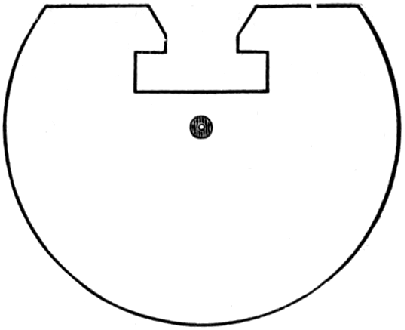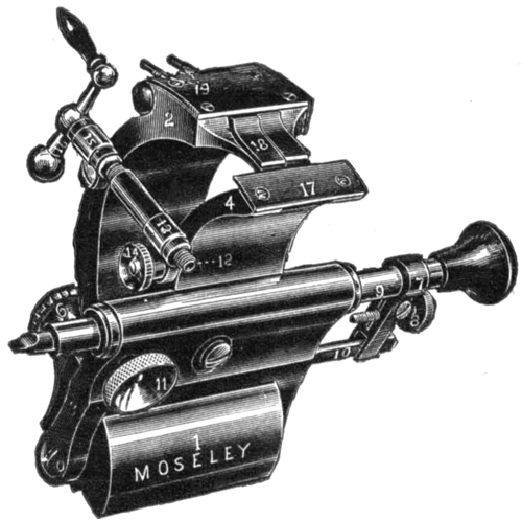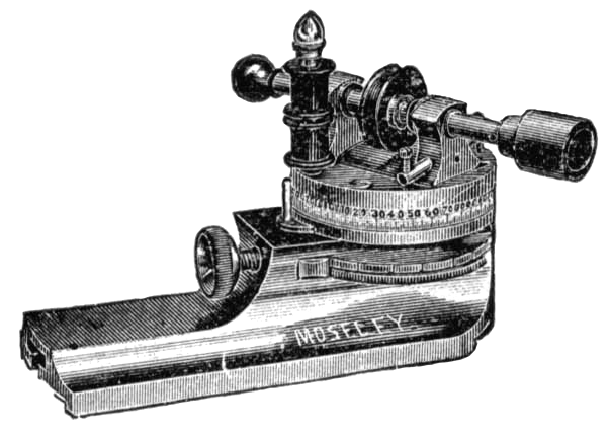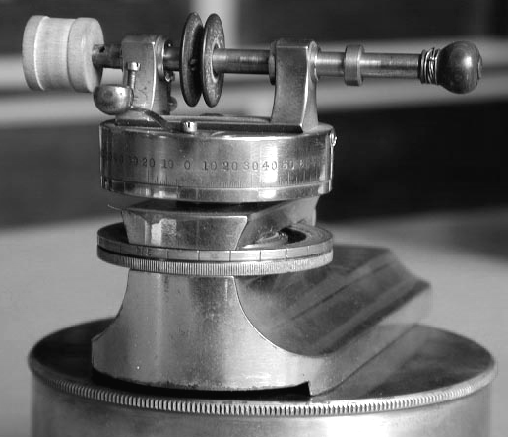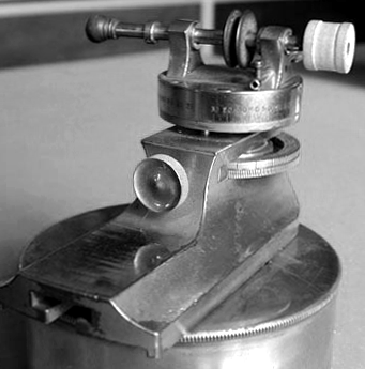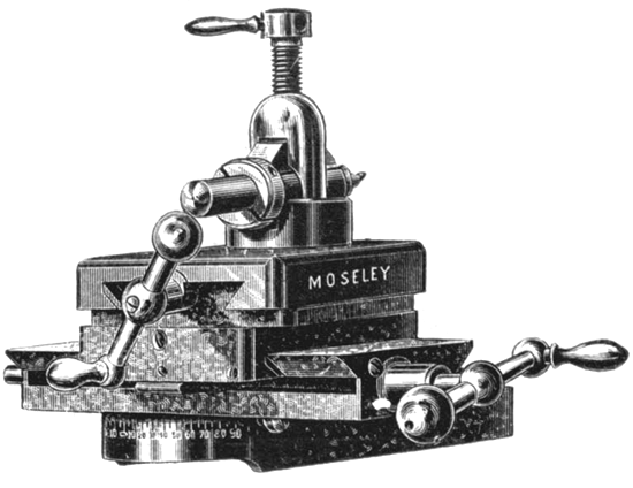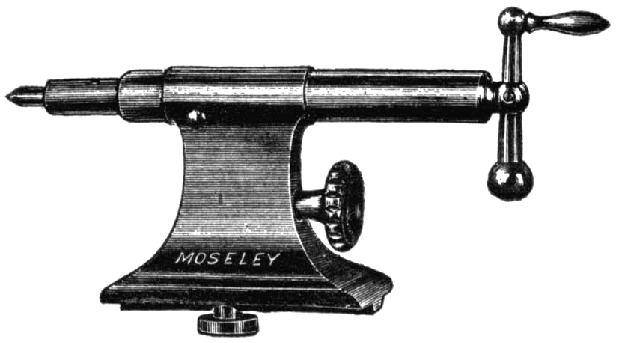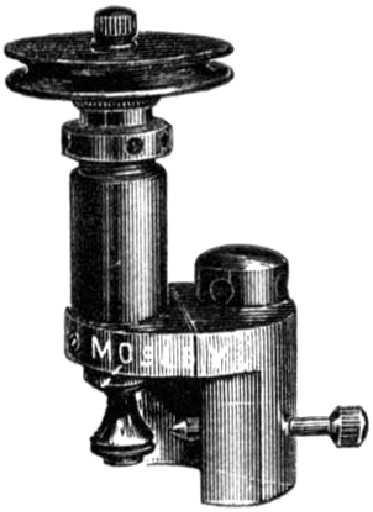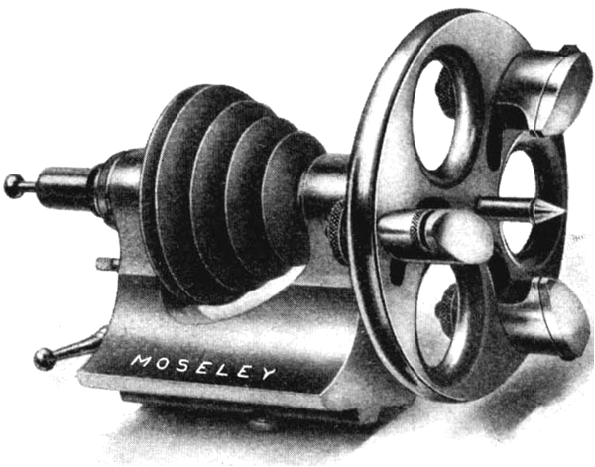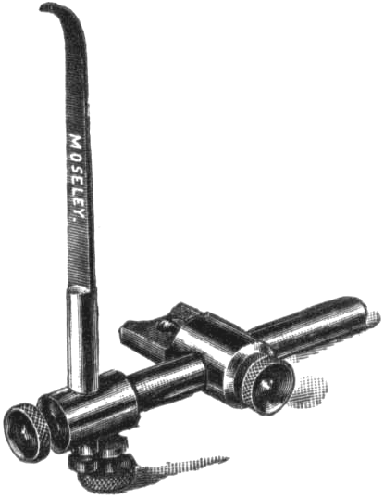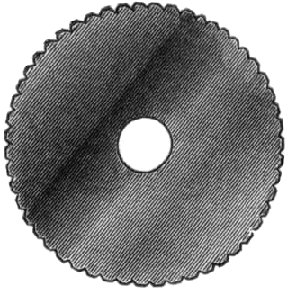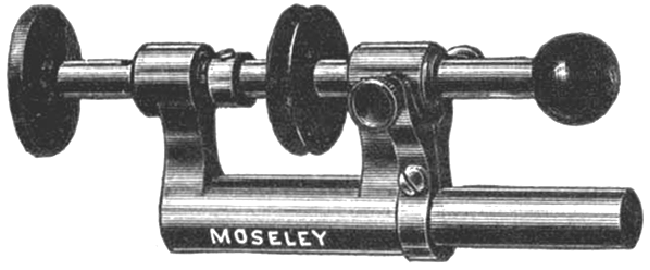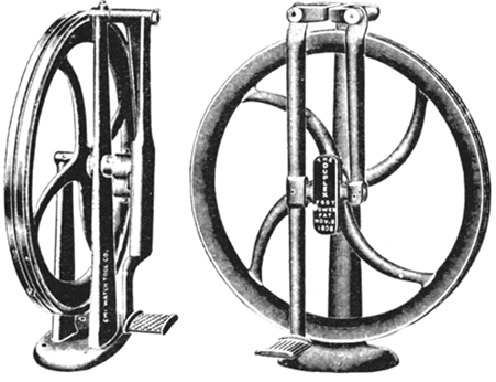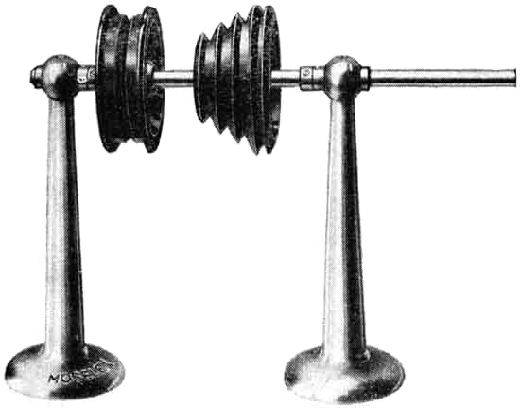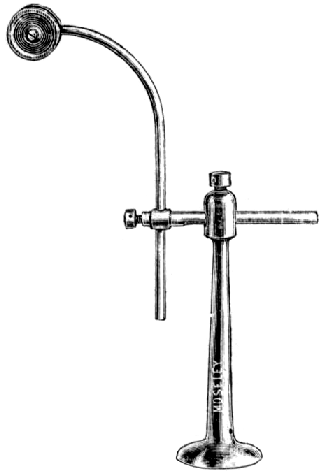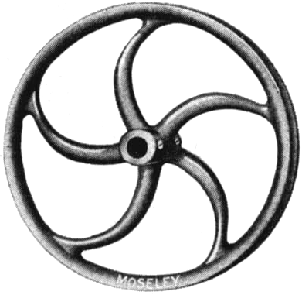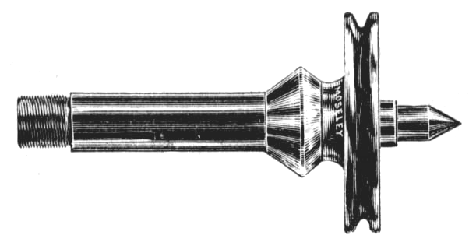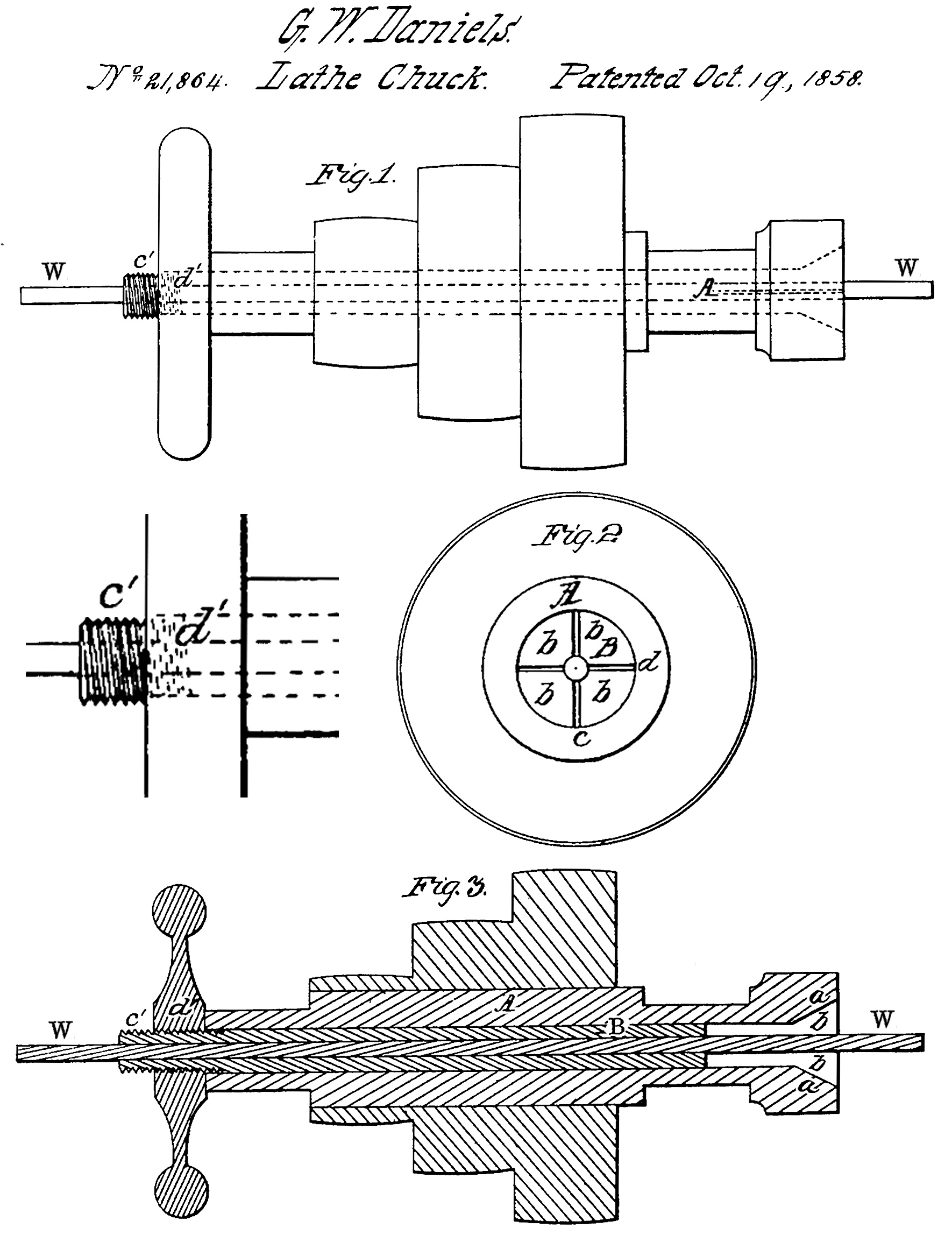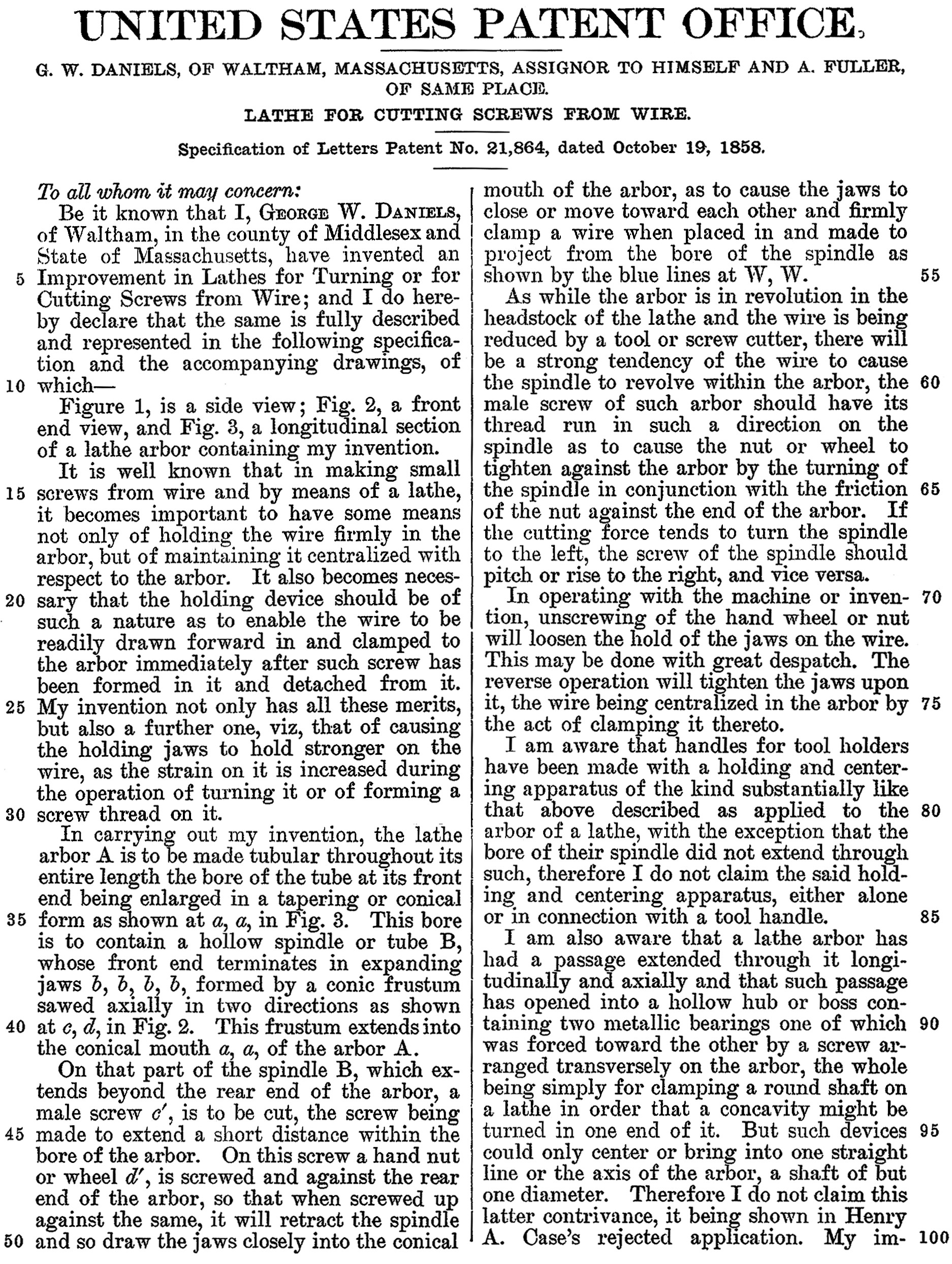|
Amongst the users of the watchmakers' lathe, are many who know that one of the most important developments in its design was the introduction by Charles Moseley - in 1857/58 - of the hollow-spindle type that allowed the use of high-precision, draw-in collets, or 'chucks' and 'split chucks' as they were initially called. At the time, Moseley was working for the American Watch Company in Waltham, Massachusetts, as the machine department's foreman, and his first lathe resembled what is now known as the "Geneva" type with its round bed and generally light build. In 1859, Moseley joined the Nashua Watch Company as a master mechanic - and it has always seemed strange that, despite later having eleven watch-related patents to his name, this gifted man never patented his breakthrough collet (significantly so when many other far less critical and unsuccessful ideas to improve the watchmakers' lathe had been). However, we now have the answer for, in researching the subject, the writer came across a patent that described precisely the ideas incorporated in Moseley's lathe. It was taken out by George W. Daniels and a Mr A.Fuller, both residents in the watchmaking and precision engineering centre of Waltham . The patent, shown below, was granted on October 19th, 1858, and though the application date is not stated, it could have been up to one year before. If we include the time necessary from the idea's inception to the development of prototypes, experiments with different materials and the possibility of pre-production examples being made in the early months of 1858, this matching of dates appears significant. Did Moseley take up a licience to use the patent - or buy it outright? If so, the latter must be the more likely as it appears to have been used exclusively by him until its expiry 20 years later.
Turning the legalese of the patent (shown at the bottom of this page) into straightforward English and using modern terms, we have the following description of the Moseley-Fuller patent:
"It's well known that using a lathe to make small screws from wire requires a firm grip on the material, accurate centring and, once a job is finished, a way of allowing the wire to be pulled out for the next to take place. In addition, my invention causes the jaws holding the work to exert a firmer grip as it rotates and is cut or formed into a thread.
In my invention, the spindle in a lathe's headstock is bored through to become hollow, with the end face towards the tailstock formed with a short internal taper. Into the spindle is fitted a collet - a short, close-fitting tube that can be provided with different internal diameters. At the front end, the collet is swollen in diameter and formed with an external taper that matches that of the headstock spindle - the other end being provided with a male thread. The swollen and tapered end is sawn across with four slits that produces four equal sectors so that, when the collet is drawn into the spindle taper, the sectors are compressed inwards and grip what is being held. To hold the collet in place, a tube with a thread in its end matching that on the collet is passed down the hollow spindle and screwed onto the collet. The other end of the tube is fitted with a handwheel that abuts against the outer face of the headstock so that, when this is turned, the collet is drawn tightly against the taper in the headstock spindle and its slots closed down."
The next part of the patent might indicate that only a little experimental work on the idea had been carried out for it continues:
While the spindle is rotating and a cut is being taken, there will be a strong tendency for the work to try and rotate the collet inside the spindle. To prevent this from happening, if the spindle is rotating anti-clockwise when viewed from the collet end, the thread on the end of the collet should be left-handed so that the draw-tube handle is drawn more tightly against the end face of the headstock instead of slackening. If the spindle's rotation direction is clockwise, the thread on the end of the collet should be right-handed.
If this idea of left and right-hand threads were ever used on production examples I do not know, but in practice, to prevent rotation, collets were developed with a short 'keyway' that engaged with a small pip inside the spindle, the draw tube thus only requiring a normal right-hand thread.
A seminal invention - and not only for watchmakers' lathe but most other types too - the collet lathe allowed previously tricky jobs to be turned with far greater ease and much-improved accuracy. Material the diameter of wire could be held with perfect security and, in addition, collets were developed into a vast range of types, including ones with internal threads to hold such as brass plates of various diameter to which items could be held with the long-established wax method; collets of the 'ring-step chuck' or 'fir-tree' type with several different diameters to hold hollow jobs; collets formed with a set of precisely-formed different internal diameters and called 'stepped chucks' to hold round thin, round work; collets holding self-centring 3 and 6-jaw chucks (these often having screwed-on, face-reversible jaws) and 'universal chucks' with four independent jaws; collets with a drill chuck on their end; collets to hold gears (called 'wheels' by watchmakers); collets with a screw-thread end to screw into and so allow the turning of wood, the collet-mounted 'box chuck' with four radially-disposed screws to act as a crude 4-jaw chuck, collets with a built-in tapping attachment, special lantern chucks in bronze and steel, collets called 'balance chucks', and ones to hold pocket watch 'crowns' - etc. Illustrations of these collet fittings can be found on this page..
Hence, Moseley were a long-established American maker of fine-quality watchmaking lathes - production from their factory in Elgin, Illinois, spanning a period from the late 19th to around the third decade of the 20th centuries. Competition in the watch-lathe business was always fierce and the company was eventually incorporated into C. & E. Marshall of Chicago, who also marketed the Marshall and Peerless WW type lathes.
Moseley lathes were, in the parlance of the time, "all-hard" - meaning that they were of superior quality, not a poor imitation of the real thing - of which there were many - and used top-quality materials, properly prepared and carefully assembled by skilled craftsmen.
In the words of the catalog: "The Headstock Spindle which receives the Chucks, the Loose Bearing which is fitted to the Spindle, and the Front and Rear Bushings in which they run are all made of the Best Quality of High Carbon Crucible Tool Steel carefully Tempered to a High Degree of Hardness and Ground to Standard and Alignment by Special Grinding machinery, using Special Carborundum and Alundum Abrasive Wheels."
To ensure absolute accuracy and concentricity the spindle was assembled into its "Double Combination 3 and 45-degrees angle" bearings before being finish ground on the internal, collet-locating taper. The spindle assembly was adjusted by just one slotted and knurled nut at its left-hand end - whilst access to the oiling holes was by moving back the "sprung" dust shields fitted to each side of both bearings (easy when you know how, a puzzle if not told).
Hot moulded onto a metal centre the hard-rubber 4-step headstock-spindle pulley wheel was equipped with a single ring of 60 indexing holes around the outer (metal) face of its largest diameter - the knurled-head indexing pin used to locate the pulley (No. 18 below) being manufactured from tool steel. The durability of this type of "all-hard" headstock is well known, and several manufacturers have claimed life spans of incredible duration under normal operating conditions; the Moseley Company was no exception and proudly announced that lathes over thirty years old, which had been back to the works for "minor repairs", had headstock bearings in: "as good a condition as when they were first sent out.".
Both headstock and tailstock were locked to the bed by a single clamp, the arrangement for each assembly being identically and neatly engineered with the eccentric operating rods passing through their respective casting to emerge conveniently for the operator's fingers on the end faces (Nos. 22 and 31 below).
Of the traditional "push" type the original standard tailstock had just a simple sliding barrel (made from hardened, ground and lapped tool steel) locked by an eccentric and lever. The barrel was fitted with a taper in one end to hold the necessary fittings - and provided with an ejection slot to remove them. As an optional extra, a screw-feed tailstock was offered - and described by the makers as being for "a heavier class of drilling and other operations …"
Like all makers of watchmakers' lathes, Moseley produced a wide range of accessories, including some rather interesting ones included amongst which were a very fine jewelling calliper rest, a neatly designed pivot polisher and a quite astonishing (and possibly unique in its class) slide-mounted capstan unit.
Numbers of these lathes survive - though often with no accessories and in a neglected state. When buying a watchmakers' lathe always try to find one complete in its maker's fitted box complete with as wide a range of accessories as possible; some hints and tips together with a list of makers and accessories can be found here..
|
|







